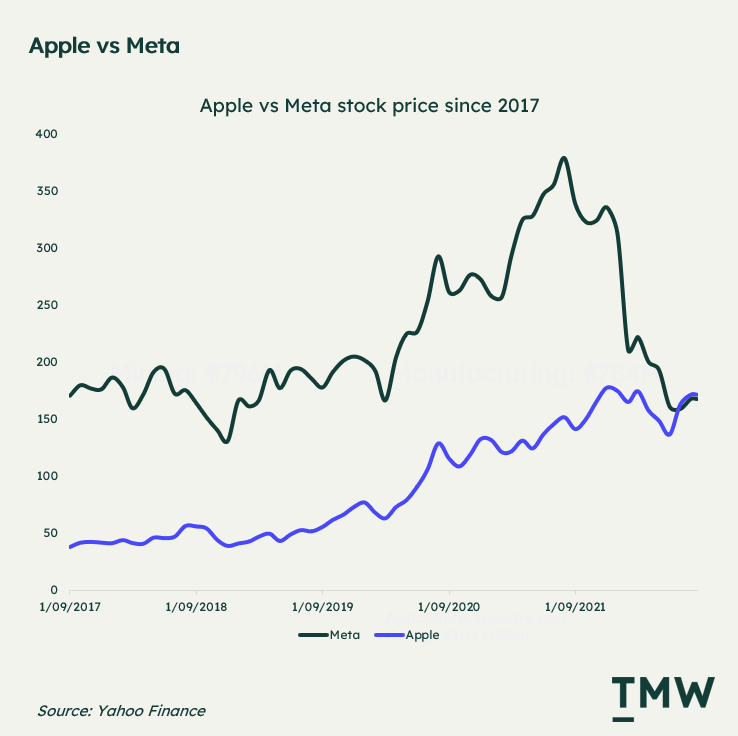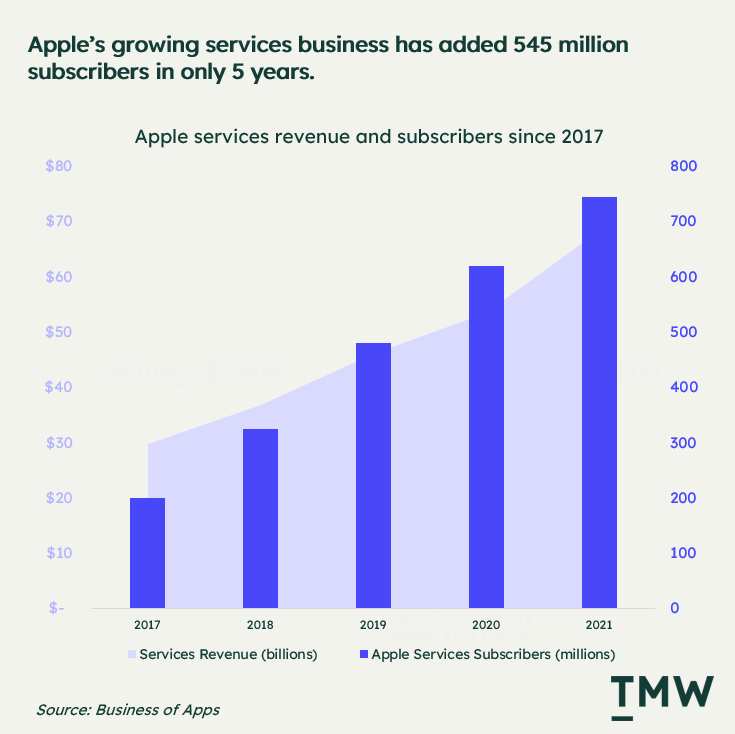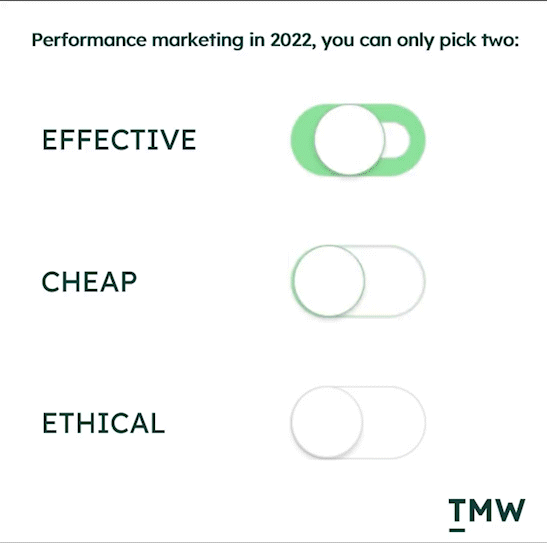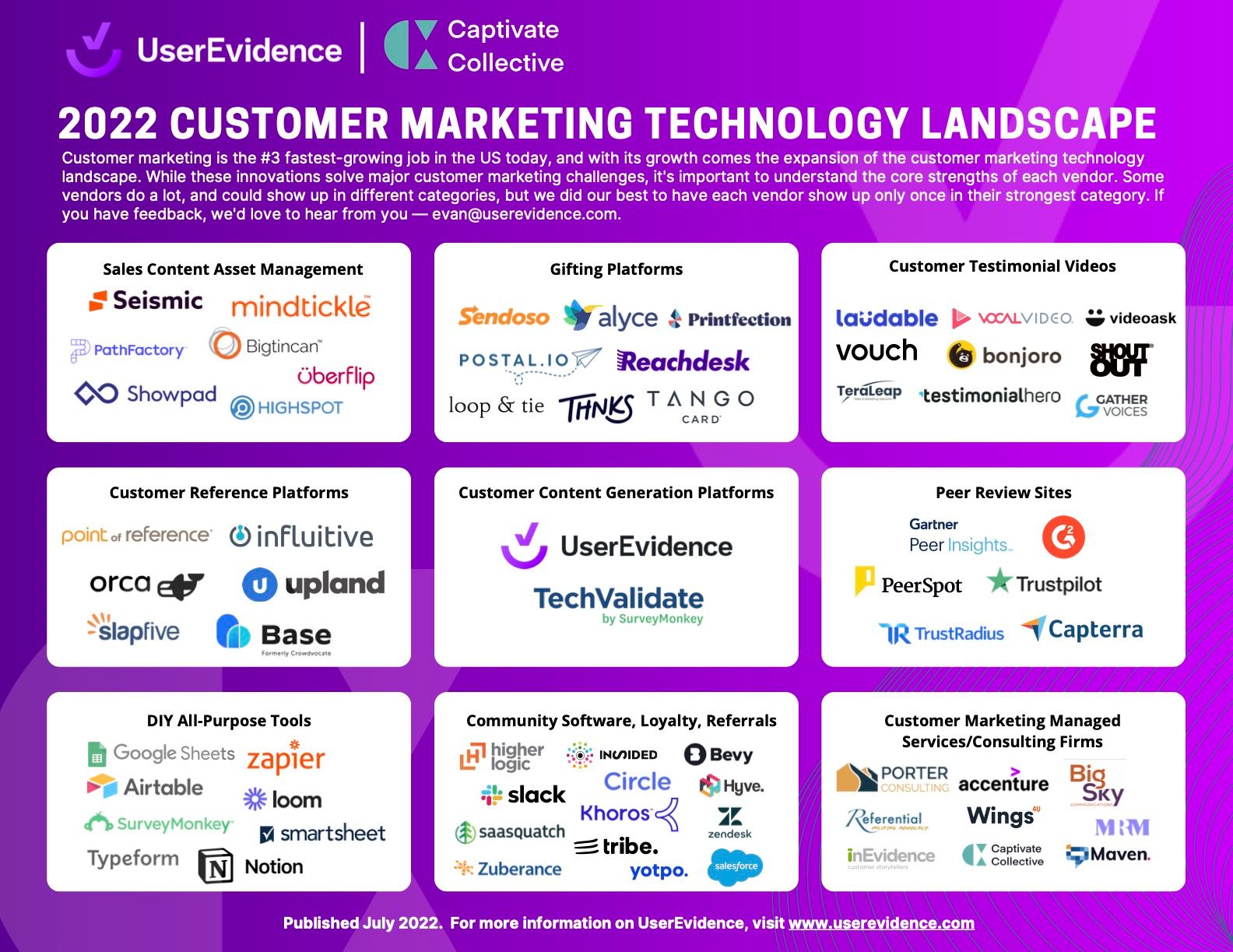TMW #093 | Apple's ad advantage
Welcome to The Martech Weekly, where every week I review some of the most interesting ideas, research, and latest news. I look to where the industry is going and what you should be paying attention to.
👋 Get TMW every Sunday
TMW is the fastest and easiest way to stay ahead of the Martech industry. Sign up to get the full version delivered every Sunday for this and every TMW, along with an invite to the TMW community. Learn more here.
Here’s the week in Martech:
- Apple's ad advantage: Privacy, narratives, and competition
- Customer marketing tech landscape: What it does in a business
- Paying for Snapchat. Breaking the ad-supported social network hypothesis
- Everything else: The publisher to ad network pipeline, technology panics, how governments invest in tech, Youtube across the generations, scaling brand safety, and an AI viral post generator for LinkedIn
✍ Commentary
Apple's ad advantage
It’s only a 25-minute drive down Bayshore Freeway to get from Apple to Meta headquarters. Yet, despite being so geographically close, Apple and Meta are worlds apart when it comes to privacy.
These two companies have become opposite ends of a spectrum in a privacy discussion driven by government regulation, careful narrative engineering and competitive opportunism. What has emerged are two narratives, the first is Apple as the champion of our human right to privacy, and the second is Meta - the abuser of your personal data through aggressive tracking and targeting.
Because of these two narratives, the stock market is reacting. Amid a broader tech downturn, Meta’s slowing user growth, excessive spending on the “metaverse” and most importantly, data collection limitations imposed by Apple, confidence that Meta has a viable future has been waning, but Apple is only going from strength to strength.

Who leads the privacy narrative?
One of the big reasons for Apple’s continuing growth and Meta’s decline over the past twelve months is how both companies have addressed an increasingly chaotic public debate about what it means to have privacy online. If you take the 25-minute drive from Apple to Meta, what you’re likely to see are swaths of billboards plastered with “Privacy, that’s iPhone.” There’s a reason for this.
Since 2019 Apple’s media efforts have been pushing a growing narrative that big tech is violating your privacy. In doing so Apple created an offensive position on a hot-button topic that is influencing internet regulation, consumer attitudes, and product roadmaps for Adtech companies and publishers.
The offensive started with a guest essay from Tim Cook for Time magazine back in 2019. In that piece, he said “We think every user should have the chance to say, “Wait a minute. That’s my information that you’re selling, and I didn’t consent.” In reality, for most cases consumers do consent to this, we just don’t have the time or attention to read the privacy policies. But herein lies the kernel of the privacy debate – people should have more control over how their data is being used online.
But it wasn’t just TVs ads and billboards that Apple used in their offensive against online tracking. In 2021 Apple introduced Apple Tracking Transparency, which asks users if apps can track them. Additionally, Apple also deprecated third parties cookies in Safari in 2020 and recently launched iCloud private relay, a tool that masks your identity online. This is not good news for Meta, a company that has its services and data collection practices built on top of the Apple app store ecosystem.
Privacy plot holes
Tech analyst Benedict Evans points out in a recent essay on privacy that despite Apple leading the privacy narrative, there are a number of plot holes and contradictions that make Apple’s position harder to believe:
Plot hole #1 – Shifting the goal posts of what we mean by tracking doesn’t make it any more private. Just because it’s on the device and not in the cloud, does that matter at all to the consumer?
Apple has pursued a very clear theory that analysis and tracking is private if it happens on your device and is not private if leaves your device or happens in the cloud. Hence, it’s built a complex system of tracking and analysis on your iPhone, but is adamant that this is private because the data stays on the device.
Plot hole #2 – Apple is tracking users without consent for several other reasons outside of targeted ads. Where does privacy begin and end? According to Apple, it’s whatever Meta and Google are doing with your data.
Apple also created a CSAM scanning system that it thought was entirely private - ‘it only happens on your device!’ - that created a huge privacy backlash, because a bunch of other people think that if your phone is scanning your photos, that isn’t ‘private’ at all. So is ‘on device’ private or not? What’s the rule? What if Apple tried the same model for ‘private’ ads in Safari?
Plot hole #3 – Only Apple can decide what consent can mean for an entire industry. Other apps ask to track you, while Apple asks to personalize your ads. You don’t need consent when it’s on the device, but does this also apply to other platforms?
Meanwhile, Apple’s on-device tracking doesn't ask for permission, and opts you in by default, because, of course, Apple thinks that if it's on the device it's private. Perhaps ‘consent’ is not a complete solution after all.
Plot hole #4 – All other ad vendors are somehow evil. Despite Apple having the ability to use our most intimate and personal data, it is morally wrong for companies to have the ability to show a relevant ad based on a combination of behaviors.
Advertisers don’t really want to know who you are - they want to show diaper ads to people who have babies, not to show them to people who don’t, and to have some sense of which ads drove half a million sales and which ads drove a million sales. Targeting ads per se doesn’t seem fundamentally evil, unless you think putting car ads in car magazines is also evil.
As you can see, Apple's capitalizing on something more than a simple industry disagreement. The concept of privacy, even after twenty years of debate and discussion is in a constant state of confusion. We can’t decide on what consent, tracking, and targeting means in a way that applies to the industry broadly.
This makes for dominant companies like Apple to cut through the noise with a simple framing of a complex problem and position themselves on the moral higher ground. The sheer brilliance of Apple is its ability to turn narratives into products, and that’s exactly what they’ve done here with privacy.
All roads lead to ads
Most of what I’ve explained to you so far has been about Apple in 2019 – 2021. In 2022 Apple has made significant changes to how it invests in its own ads business. The first move was introducing native advertising in the app store search function and the company is now expanding the app store ad footprint by adding placements within the experience.
The second and most recent move is the Apple Demand Side Platform. According to recent job filings, Apple is looking for AdTech engineers to build the service. This is a step toward a programmatic offering that will allow brands to bid for ad placements. These are all deliberate movements towards a platform play consisting of a walled garden of customer data that can be sold to the highest bidder for ads.
And it's working. Over the last five years, Apple has grown its advertising business from $300 million to over $4 billion.
Apple also has plenty of reasons to build advertising products into its core services business. The company has been on a half-decade quest to build subscription revenue products across its services, recently launching Apple Fitness, Apple Music, Apple TV+, and Apple News.
So far, this strategy has worked. The company has scaled revenue to $70 billion in 2021, more than double what it was five years ago. Apple users with a paying subscription are nearly three times that of Amazon Prime. When you have that many users running through a diversified portfolio of applications that target all kinds of interest groups, what you have are a rich pool of customer data from which detailed segmentation and targeting can be built.

Apple’s movement into Ads is still relatively new and has no certain future. The advantage the company has is its ability to tie together customer identity to hardware and software. Apple has always been a closed ecosystem, but since the App store companies have been building products and services, creating a somewhat open space for software development.
But now that the company’s 30% tariff on every in-app purchase is being threatened, revenue has to come from somewhere, and building an ad network seems more like an opportunistic side quest, than something the company really wants to build. If it's taken this long for Apple to do something with ads, you have to ask why that is.
Apple’s strengths have never been in software anyway. Apple Music never disrupted Spotify, its fitness app is designed for 20 somethings that live in California, and don’t get me started on the Podcast app. Apple’s office products also lack features compared to Microsoft.
Sure, they’ve been able to corner the market with professional applications like Logic Pro and Final Cut, but for Apple to really scale its advertising efforts, it has to build something akin to a social network or a search product. New territory for a company that’s really just finding its footing in the software market again.
An Apple marketing platform?
The big question here is if Apple’s move into advertising looks like a skirmish or a war. In other words, can the company build a platform for marketers that can extend across its network of apps and into the applications outside of its ecosystem, or is it trying to eke out more revenue from the App store model?
On the one hand, if Amazon is setting the building blocks of its own Advertising Platform, then why can’t Apple do the same? There are plenty of good reasons for Apple to head in this direction, one of which is the ability to continue to control the narrative while capitalizing on a broken AdTech industry that lacks direction and a path towards a more ethical future.
On the other hand, as Web Smith from 2PM puts it well here that even if Apple can build something like a social graph or a way to drive user-generated content, the blowback from business owners will be severe, because it’s unlikely that the options that exist today with Meta and Google will be available with Apple, because… check notes…. privacy.
Apple will need to continue growing its content marketplace; Tim Cook’s digital fiefdom will require greater (user-generated) content engagement. As such, it’s not a leap in logic that Apple will build a platform for user-generated content (UGC). Don’t be surprised if Apple acquires one in the process. Twitter, anyone? Without greater advertising opportunity within the Apple ecosystem, digitally-native businesses will suffer from the collateral damage. Apple has become the solution for handheld consumer privacy; business owners deserve a capable alternative to the services that Apple is crushing with its new practices.
This does raise the question, if Meta and Google brought us the age of cheap and effective ways to grow businesses through targeted advertising, then Apple’s approach here will be to leverage a moral imperative to protect privacy.
The problem is that taking the ethical road is the more expensive one and small businesses will need to choose. A more ethical web is a more expensive and less effective one, especially if you’re wanting to buy ads.

Competing is surviving
Another way to think about Apple’s privacy narrative coinciding with a growing ad business is its impact on competitors. Most companies that are running programmatic advertising have already been hurt by Apple’s implementation of ATT. But recent research into how platforms like TikTok and Instagram are already changing how they think about tracking users within the app.
One method that social networks are using to side skirt tracking limitations is through in-app browsing tools. By loading a browser within the app, TikTok and Instagram have far greater control over what data is collected from a user, and as long as users don’t leave the browser, there are more opportunities to profile customers beyond how they are using just the app. Data from Felix Cruise, who is researching the technology suggests that TikTok can measure just about everything within this environment, including keystrokes.
Right now the in-app browser is international waters when it comes to tracking. It’s not technically “app usage” and covered by ATT rules, nor is it an external browser like Safari that has third-party cookies blocked. So expect social media networks to exploit grey area loopholes like this to survive.
The other method is to incentivize the on-platforming of commerce-related activities. Once a user is asked to visit a website, the chain of tracking is often broken. That’s why Meta, Google, and many other major applications are wanting to bring eCommerce into their platforms.
This is driven by the kinds of first-party data that can be shared and how it can be collected. It also makes it easier to report back on conversions without relying on pixels and tracking systems that are increasingly becoming obsolete on a private web. In this way, Apple’s focus on privacy creates incentives to further centralize content consumption and commerce into the hands of a very few global companies.
But Apple, at the end of the day, has a line of sight to having a significant advantage. Owning the hardware, software, and attention of users means that the company has far greater control over what every other company can do on its platform. If Apple is serious about building tools for marketing and advertising, then it’s entirely possible that the competitors of today will become the memories of tomorrow.
📈Chart Of The Week
Customer marketing technology landscape. An interesting spin on how we might understand what customer marketing technology is and what it does in a business. The categories in this chart, like customer content generation, never really grew into something big enough but they have specific use cases that make a ton of sense for marketers. Link

📰 Latest Developments
Paying for Snapchat. The company has generated $48 million in ARR in the first month of launching its low-cost subscription service. Snapchat also decommissioned the newly launched Pixie drone this week. The company seems to continue to defy gravity as it pulls in a bunch of different directions. The Snapchat+ launch is one good example as it breaks the hypothesis that people won’t pay for social media. Maybe there is a better way outside of running ads? SNAPCHAT+PIXIE
CM group - best overall Martech company? The Breakout Martech awards named this company as the best overall. CM group is kind of like a holding company that owns several brand-name marketing technology firms. One of the more notable in their portfolio was the acquisition of Cheetah Digital in 2021. It’s an interesting strategy where instead of trying to integrate all their acquisitions into a platform, like Oracle or Salesforce, they treat each company as a standalone offering targeting specific needs for a variety of Martech buyers. Link
The publisher to ad network pipeline. This week Buzzfeed announced the global expansion of Lighthouse, their first-party data consumer insights and targeting platform. Give a publisher enough time and they’ll magically turn into a DSP. Link
📚 Reading
Breaking technology panics. A fascinating deep dive into how online communications relate to well-being and societal health. This also helps to explain negative attitudes towards innovation in marketing and technology. Link
How governments invest in tech. Scott Galloway on how most of the important innovations in tech have been supported by government funding. He calls the founders of these companies “welfare queens” (LOL). Link
The four forces of bad content. When self-promotion, nativity, deference to data and overly descriptive writing collides. You get…. This. Link
🔢 Data & Insights
The value of a welcome program. Bluecore has done a study into email effectiveness. Welcome programs have the best engagement and first purchase metrics. Link
YouTube continues to defy entropy. Stats from Pew Research challenge the idea that social networks have a generational transition challenge. In 2022, 95% of teenagers are using Youtube compared to 67% for TikTok and 62% for Instagram. Not all social networks have a generational problem. Link
How D2Cs are surviving the tech downturn. Link
💡 Ideas
Underestimating DOOH. There are many use cases in the Digital Out of Home category that remain unexplored because marketers don’t understand what DOOH is. Link
Scaling brand safety. There’s an interesting divergence between brands that use brand safety technology in their advertising stack and those that don’t. How do you scale reputation management? Companies with budgets are thinking about this question as the web becomes more divisive and unpredictable. Link
Martech architecture cheat sheet. A good overview of all the critical aspects of marketing technology in a company and how they work together. Most people think in terms of “ Martech stacks” but in reality, there’s a jumble of technologies that have direct and indirect relationships with each other. Link
✨ Weird and Wonderful
Viral post generator. Someone modified an off-the-shelf AI tool to help us write viral LinkedIn content. We are all doomed. Link
Zuckerburg and peer pressure. Zuck did a social media post announcing the Meta Horizons World product launch in Europe. Twitter users ridiculed the awfully bad graphics - “$10 billion and it really looks like a 15-year-old Nintendo game?” and so he did a follow-up post with an upgraded avatar and a promise that the product will have better graphics soon. It’s really amazing that after all these years of bad PR and controversy that Zuckerburg is still the face of his products. Link
The fall of the Kardashians and the evolution of entertainment. Or why they want “the old Instagram back.” Link
Stay Curious,
Make sense of marketing technology.
Sign up now to get TMW delivered to your inbox every Sunday evening plus an invite to the slack community.
Want to share something interesting or be featured in The Martech Weekly? Drop me a line at juan@themartechweekly.com.
